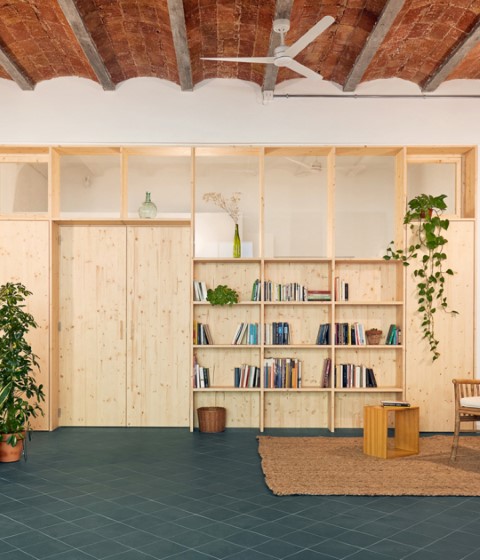For the main entrance, with a door from the street that connects to the town square, a double-height lobby has been recreated with a staircase like those built in the town until the 1950s. The railing, designed by the studio and built by local artisans, is inspired by the staircase of the Casa Chitarrini building (1950) by Mario Ridolfi, as well as the current Palissade furniture line by Ronan & Erwan Bouroullec, for finding in them the common craft tradition.
The project maintains the noblest finishes or decorative elements that were in the part of the old house, becoming one of the most characteristic elements of the project. Hydraulic pavements or chandeliers have spread to other areas, adding an ambiguous nobility to the old productive spaces. For the same purpose, the coloUrs of the original pavement have been diffused in the new floors, ceilings and walls.

Casa Patchwork by Funcionable Arquitectura. Photograph by Imagen Subliminal.
Description of project by Functionable Architecture
Several buildings with different uses had to be rehabilitated and integrated into one to obtain a home. With reuse as the main strategy, an attempt has been made to preserve each space and each material, repositioned, connected and "stitched" in a new way, to give rise to a set that integrates the spatial and material memory of the family, as if an architectural patchwork in question. As a result, waste and construction costs have been significantly reduced.
There were five different initial areas: a segregated part of another dwelling, the mill, some stables, a hayloft and a barn with a single double-height nave below deck. The new connections are organized around the double-height space of the old mill, placing the main living area in it.
The new parts of the house accommodate the pre-existing parts with their new uses, renewing their character and meaning along the way. As a consequence, spatial hierarchies are subverted, so that the stable is a celebration room and the kitchen receives visitors.
An important part of the renovation effort has been devoted to improving the energy efficiency of the complex. With the aim of achieving an A energy rating, the entire envelope has been improved by adding insulation to the opaque parts and renovating all the carpentry with high-performance profiles and glass. In addition, thermal installations have been replaced to achieve greater efficiency through aerothermal energy. For the main entrance, a door opens onto the street that leads to the square, and there is a double-height lobby with a staircase like those of some houses that were built in the town until the 1950s. For the railing, the reference to the staircase of the Casa Chitarrini building (1950) by Mario Ridolfi, as well as the current Palissade furniture line by Ronan & Erwan Bouroullec, for finding in them the trace of a common craft tradition.
Some of the noblest finishes or decorative elements that were in the part of the old house have been extended to the rest of the rooms so that they are a recognizable motif that helps to effectively integrate the new set. Thus, hydraulic pavements or chandeliers have colonized other areas, adding an ambiguous nobility to the old productive spaces. For the same purpose, the colours of the original pavement have been diffused in the new floors, ceilings and walls, amplifying the footprint of the pre-existing.

































































